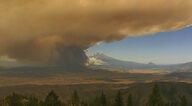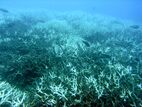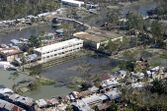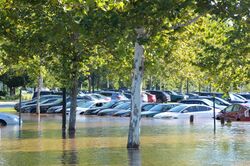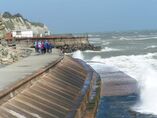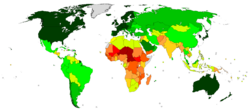Climate change vulnerability

Climate change vulnerability (or climate vulnerability or climate risk vulnerability) is a concept that describes how strongly people or ecosystems are likely to be affected by climate change. It is defined as the "propensity or predisposition to be adversely affected" by climate change. It can apply to humans and also to natural systems (or ecosystems).[1]:12 Related concepts include climate sensitivity and the ability, or lack thereof, to cope and adapt.[1]:5 Vulnerability is a component of climate risk. Vulnerability differs within communities and across societies, regions, and countries, and can increase or decrease over time.[1]:12
Vulnerability of people and ecosystems with regards to climate change effects is driven by certain unsustainable development patterns such as "unsustainable ocean and land use, inequity, marginalization, historical and ongoing patterns of inequity such as colonialism, and governance".[1]:12 Therefore, vulnerability is higher in some locations than in others. Certain aspects within a region increase vulnerability, for example poverty, bad governance and violent conflict. Some types of livelihoods are regarded as particularly climate-sensitive, resulting in a higher level of climate change vulnerability. These include for example smallholder farmers, pastoralists and fishing communities.[1]:12
Vulnerability can be grouped into two overlapping categories: These are economic vulnerability, based on socioeconomic factors, and geographic vulnerability. People who are more vulnerable than others include for example people with low incomes, indigenous peoples, women, children, the elderly.
There are several tools available to assess climate vulnerability. Because climate vulnerability disproportionately affects low-income countries, climate vulnerability has become an important tool in international negotiations about climate change adaptation, climate finance and other international policy making activities.
Definition
Climate change vulnerability is defined as the "propensity or predisposition to be adversely affected" by climate change. It can apply to humans but also to natural systems (ecosystems), and both are interdependent.[1]:12 Vulnerability is a component of climate risk. Vulnerability will be higher if the capacity to cope and adapt is low.[1]:5
Climate vulnerability can include a wide variety of different meanings, situations, and contexts in climate change research, and has been a central concept in academic research since 2005.[2] The concept was defined in the third IPCC report in 2007 as "the degree to which a system is susceptible to, and unable to cope with, adverse effects of climate change, including climate variability and extremes".[3]:89 The IPCC Sixth Assessment Report in 2022 stated that "approaches to analysing and assessing vulnerability have evolved since previous IPCC assessments".[1]:5
In the context of political economy, vulnerability is defined as “the state of individuals, groups or communities in terms of their ability to cope with and adapt to any external stress placed on their livelihoods and well-being.”[4] Vulnerability is a relative concept, not an absolute one, meaning that "some people are less or more susceptible than others, at different times and places".[4]
Research in this area focuses on analysing the factors that "put people and places at risk and reduce capacity to respond".[5]
Types
Vulnerability can be grouped into two overlapping categories: economic vulnerability, based on socioeconomic factors, and geographic vulnerability. Neither are mutually exclusive.
Economic vulnerability
At its basic level, a community that is economically vulnerable is one that is ill-prepared for the effects of climate change because it lacks the needed financial resources.[6] Preparing a climate resilient society will require huge[quantify] investments in infrastructure, city planning, engineering sustainable energy sources, and preparedness systems.[clarification needed] From a global perspective, it is more likely that people living at or below poverty will be affected the most by climate change and are thus the most vulnerable, because they will have the least amount of resource dollars to invest in resiliency infrastructure. They will also have the least amount of resource dollars for cleanup efforts after more frequently occurring natural climate change related disasters.[7]
Vulnerability of ecosystems and people to climate change is driven by certain unsustainable development patterns such as "unsustainable ocean and land use, inequity, marginalization, historical and ongoing patterns of inequity such as colonialism, and governance".[1]:12 Therefore, vulnerability is higher in some locations than in others. Certain aspects within a region increase vulnerability, for example poverty, governance challenges and violent conflict. Some types of livelihoods are regarded as particularly climate-sensitive, resulting in a higher level of climate change vulnerability. These include for example smallholder farmers, pastoralists and fishing communities.[1]:12
Societal vulnerability to climate change is largely dependent on development status.[8]:336 Developing countries lack the necessary financial resources to relocate those living in low-lying coastal zones, making them more vulnerable to climate change than developed countries.[9]:317
Geographic vulnerability
A second definition of vulnerability relates to geographic vulnerability. The most geographically vulnerable locations to climate change are those that will be impacted by side effects of natural hazards, such as rising sea levels and by dramatic changes in ecosystem services, including access to food. Island nations are usually noted as more vulnerable but communities that rely heavily on a sustenance based lifestyle are also at greater risk.[10]
Vulnerable communities tend to have one or more of these characteristics:[11] food insecure, water is scarce, delicate marine ecosystem, fish dependent, small island community.
Around the world, climate change affects rural communities that heavily depend on their agriculture and natural resources for their livelihood. Increased frequency and severity of climate events disproportionately affects women, rural, dryland, and island communities.[12] This leads to more drastic changes in their lifestyles and forces them to adapt to this change. It is becoming more important for local and government agencies to create strategies to react to change and adapt infrastructure to meet the needs of those impacted. Various organizations work to create adaptation, mitigation, and resilience plans that will help rural and at risk communities around the world that depend on the earth's resources to survive.[13]
Scale
It has been estimated in 2021 that "approximately 3.3 to 3.6 billion people live in contexts that are highly vulnerable to climate change".[1]:12
The vulnerability of ecosystems and people to climate change is not the same everywhere: there are marked differences among and within regions (see regions that are particularly vulnerable below).[1]:12 Vulnerability can also increase or decrease over time.[1]:5
People who are more vulnerable
People who are more vulnerable to the effects of climate change than others include for example people with low incomes, indigenous peoples, women, children, the elderly. For example, when looking at the effects of climate change on human health, a report published in The Lancet found that the greatest impact tends to fall on the most vulnerable people such as the poor, women, children, the elderly, people with pre-existing health concerns, other minorities and outdoor workers.[14]:13
Causes
There can be "structural deficits related to social, economic, cultural, political, and institutional conditions" which would explain why some parts of the population are impacted more than others.[5] This applies for example to climate-related risks to household water security for women in remote rural regions in Burkina Faso[5] or the urban poor in sub-Saharan Africa.[4]
Vulnerability for people of a certain gender or age can be caused by "systemic reproduction of historical legacies of inequality", for example as part of "(post)colonial, (post)apartheid, and poverty discrimination".[4] Social vulnerability of people can be related to aspects that make people different from one another (gender, class, race, age, etc.), and also the situational variables (where they live, their health, who lives with them in the household, how much they earn).[4]
Reducing vulnerability
Vulnerability can be reduced through climate change adaptation measures.[1]:5 For this reason, vulnerability is often framed in dialogue with climate change adaptation. Furthermore, measures that reduce poverty, gender inequality, bad governance and violent conflict would also reduce vulnerability. And finally, vulnerability would be reduced for everyone if decisive action on climate change was taken (climate change mitigation) so that the effects of climate change are less severe.[citation needed]
Climate change adaptation
Climate resilience
Climate justice
Equity is another essential component of vulnerability and is closely tied to issues of environmental justice and climate justice. As the most vulnerable communities are likely to be the most heavily impacted, a climate justice movement is coalescing in response. There are many aspects of climate justice that relate to vulnerability and resiliency. The frameworks are similar to other types of justice movements and include contractarianism which attempts to allocate the most benefits for the poor, utilitarianism which seeks to find the most benefits for the most people, egalitarianism which attempts to reduce inequality, and libertarianism which emphasizes a fair share of burden but also individual freedoms.[15]
Climate Vulnerable Forum
Measurement tools
Vulnerability assessment is important because it provides information that can be used to develop management actions in response to climate change.[16] Climate change vulnerability assessments and tools are available at all scales. Macro-scale vulnerability assessment often uses indices. Modelling and participatory approaches are also in use. Global vulnerability assessments are based on spatial mapping using aggregated data for the regional or national level.[17](pp1195-1199)
Assessments are also done at sub-national and sectoral level, and also increasingly for cities on an urban district or neighbourhood scale. Vulnerability assessment is also done for local communities to evaluate where and how communities and livelihoods are vulnerable to climate change. Studies can vary widely in scope and scale— for example the World Bank and Ministry of Economy of Fiji commissioned a report for the whole country in 2017-18[18] while the Rochester, New York commissioned a much more local report for the city in 2018.[19] Or, for example, NOAA Fisheries commissioned Climate Vulnerability assessments for marine fishers in the United States.[20] In some cases vulnerability assessment is done in advance of preparing local climate adaptation plans or risk management plans.[21]
Indicators and indices
Global indices for climate change vulnerability include the ND-GAIN Country Index, which measures national climate vulnerability globally, INFORM Risk Index and the WorldRiskIndex, which include social vulnerability indices.[22] Indicator approaches are also used at national and sub-national levels. They use a composite index of many individual quantifiable indicators. To generate the index value or 'score', most often a simple average is calculated across a set of standardized values. However, sometimes weighting is done according what are thought to be the most important determinants of vulnerability.
Climate vulnerability tracking starts identifying the relevant information, preferably open access, produced by state or international bodies at the scale of interest. Then a further effort to make the vulnerability information freely accessible to all development actors is required.[23] Vulnerability tracking has many applications. It constitutes an indicator for the monitoring and evaluation of programs and projects for resilience and adaptation to climate change. Vulnerability tracking is also a decision making tool in regional and national adaptation policies.[23]
Tools for vulnerability assessment
Similarly as for climate risk assessment, tools for vulnerability assessment vary depending on the sector, the scale at which the study is being carried out, and the entity or system which is thought to vulnerable. Modelling and other participatory tools include WEAP for understanding water resource vulnerabilities and assessing adaptation options. The Vulnerability Sourcebook is a guide for practical and scientific knowledge on vulnerability assessment.[24] Climate vulnerability mapping is also used to understand which areas are the most geographically vulnerable. A systematic review published in 2019 found 84 studies focused on the use of mapping to communicate and do analysis of climate vulnerability.[25]
By region
All regions of the world are vulnerable to climate change but to a different degree. With high confidence, researchers concluded in 2001 that developing countries would tend to be more vulnerable to climate change than developed countries.[26]:957–958 Based on development trends in 2001, scientists have found that few developing countries would have the capacity to efficiently adapt to climate change.[27]:957 This was partly due to their low adaptive capacity and the high costs of adaptation in proportion to their GDP.
In comparison, the climate vulnerability of Europe is lower than in developing countries. This was attributed to Europe's high GNP, stable growth, stable population, and well-developed political, institutional, and technological support systems.[28]:643
Examples for vulnerability and adaptive capacity by region include:
- Africa: Africa's major economic sectors are vulnerable to observed climate variability.[29]:435 This vulnerability contributed to Africa's weak adaptive capacity. As a result Africa is highly vulnerable to future climate change. Projected sea-level rise is likely to increase the socio-economic vulnerability of African coastal cities.
- Asia: Climate change can result in the degradation of permafrost in boreal Asia. This will make climate-dependent sectors more vulnerable and affect the region's economy.[30]:536
- Australia and New Zealand: In Australia and New Zealand, some indigenous communities were judged to have a higher level of vulnerability and low adaptive capacity.[31]:509
- Europe: Scientists judge the adaptation potential of socioeconomic systems in Europe as relatively high in 2001.[32]:643 This is due to Europe's high GNP, stable growth, stable population, and well-developed political, institutional, and technological support systems.
- Latin America: The adaptive capacity of socioeconomic systems in Latin America is very low, particularly with regard to extreme weather events. As a result the region is highly vulnerability.[33]:697
- Arctic: The Arctic is extremely vulnerable to climate change. It was predicted in 2007 that there would be major ecological, sociological, and economic impacts in the region.[34]:804-805
- Small island Developing States are particularly vulnerable to climate change.[35]:689 Partly this was attributed to their low adaptive capacity and the high costs of adaptation in proportion to their GDP.
By country
Script error: No such module "World topic".
See also
- Climate Vulnerability Monitor
- Effects of climate change
- Effects of climate change on human health
References
- ↑ 1.00 1.01 1.02 1.03 1.04 1.05 1.06 1.07 1.08 1.09 1.10 1.11 1.12 1.13 IPCC, 2022: Summary for Policymakers [H.-O. Pörtner, D.C. Roberts, E.S. Poloczanska, K. Mintenbeck, M. Tignor, A. Alegría, M. Craig, S. Langsdorf, S. Löschke, V. Möller, A. Okem (eds.)]. In: Climate Change 2022: Impacts, Adaptation and Vulnerability. Contribution of Working Group II to the Sixth Assessment Report of the Intergovernmental Panel on Climate Change [H.-O. Pörtner, D.C. Roberts, M. Tignor, E.S. Poloczanska, K. Mintenbeck, A. Alegría, M. Craig, S. Langsdorf, S. Löschke, V. Möller, A. Okem, B. Rama (eds.)]. Cambridge University Press, Cambridge, UK and New York, NY, USA, pp. 3–33, doi:10.1017/9781009325844.001.
- ↑ Füssel, Hans-Martin (2005-12-01) (in en). Vulnerability in Climate Change Research: A Comprehensive Conceptual Framework. https://escholarship.org/uc/item/8993z6nm. Retrieved 2020-12-26.
- ↑ IPCC (2007a). "Climate Change 2007: Synthesis Report. Contribution of Working Groups I, II and III to the Fourth Assessment Report of the Intergovernmental Panel on Climate Change (Core Writing Team, Pachauri, R.K and Reisinger, A. (eds.))". IPCC, Geneva, Switzerland. http://www.ipcc.ch/publications_and_data/publications_ipcc_fourth_assessment_report_synthesis_report.htm.
- ↑ 4.0 4.1 4.2 4.3 4.4 Grasham, Catherine F.; Korzenevica, Marina; Charles, Katrina J. (2019). "On considering climate resilience in urban water security: A review of the vulnerability of the urban poor in sub‐Saharan Africa" (in en). WIREs Water 6 (3). doi:10.1002/wat2.1344. ISSN 2049-1948. https://wires.onlinelibrary.wiley.com/doi/10.1002/wat2.1344.
- ↑ 5.0 5.1 5.2 Dickin, Sarah; Segnestam, Lisa; Sou Dakouré, Mariam (2021-05-28). "Women’s vulnerability to climate-related risks to household water security in Centre-East, Burkina Faso" (in en). Climate and Development 13 (5): 443–453. doi:10.1080/17565529.2020.1790335. ISSN 1756-5529. https://www.tandfonline.com/doi/full/10.1080/17565529.2020.1790335.
- ↑ Sarkodie, Samuel Asumadu; Ahmed, Maruf Yakubu; Owusu, Phebe Asantewaa (2022-04-05). "Global adaptation readiness and income mitigate sectoral climate change vulnerabilities" (in en). Humanities and Social Sciences Communications 9 (1): 1–17. doi:10.1057/s41599-022-01130-7. ISSN 2662-9992.
- ↑ M.J. Collier et al. "Transitioning to resilience and sustainability in urban communities" Cities 2013. 32:21–S28
- ↑ Nicholls, R. J. (2007). 6.4.3 Key vulnerabilities and hotspots. In (book chapter): Coastal systems and low-lying areas. In: Climate Change 2007: Impacts, Adaptation and Vulnerability. Contribution of Working Group II to the Fourth Assessment Report of the Intergovernmental Panel on Climate Change (M.L. Parry et al. (eds.)). Print version: Cambridge University Press, Cambridge, UK, and New York, N.Y. This version: IPCC website. ISBN 978-0-521-88010-7. http://www.ipcc.ch/publications_and_data/ar4/wg2/en/ch6s6-4-3.html. Retrieved 2010-05-23.
- ↑ Nicholls, R. J. (2007). Executive summary. In (book chapter): Coastal systems and low-lying areas. In: Climate Change 2007: Impacts, Adaptation and Vulnerability. Contribution of Working Group II to the Fourth Assessment Report of the Intergovernmental Panel on Climate Change (M.L. Parry et al. (eds.)). Print version: Cambridge University Press, Cambridge, UK, and New York, N.Y. This version: IPCC website. ISBN 978-0-521-88010-7. http://www.ipcc.ch/publications_and_data/ar4/wg2/en/ch6s6-es.html. Retrieved 2010-05-23.
- ↑ K. Hewitt (Ed.), Interpretations of Calamity for the Viewpoint of Human Ecology, Allen and Unwin, Boston (1983), pp. 231–262
- ↑ Kasperson, Roger E., and Jeanne X. Kasperson. Climate change, vulnerability, and social justice. Stockholm: Stockholm Environment Institute, 2001.
- ↑ "Climate Change". https://www.nri.org/publications/thematic-papers/9-climate-change/file.
- ↑ "Achieving Dryland Women's Empowerment: Environmental Resilience and Social Transformation Imperatives". https://catalogue.unccd.int/917_Dryland_women_%20Resilience_Brief.pdf.
- ↑ Romanello, Marina; McGushin, Alice; Di Napoli, Claudia; Drummond, Paul; Hughes, Nick; Jamart, Louis; Kennard, Harry; Lampard, Pete et al. (October 2021). "The 2021 report of the Lancet Countdown on health and climate change: code red for a healthy future". The Lancet 398 (10311): 1619–1662. doi:10.1016/S0140-6736(21)01787-6. PMID 34687662. http://sro.sussex.ac.uk/id/eprint/102413/1/2021%20Report%20of%20the%20Lancet%20Countdown%20revised%20_no%20refs%20ES_clean.pdf. Retrieved 2023-05-17.
- ↑ Liu, F. (2000). Environmental justice analysis: Theories, methods and practice. Boca Raton, FL: CRC Press
- ↑ "Climate Change Vulnerability Assessments | Climate Change Resource Center". https://www.fs.usda.gov/ccrc/topics/vulnerability-assessments.
- ↑ Birkmann, J., E. Liwenga, R. Pandey, E. Boyd, R. Djalante, F. Gemenne, W. Leal Filho, P.F. Pinho, L. Stringer, and D. Wrathall, 2022: Poverty, Livelihoods and Sustainable Development . In: Climate Change 2022: Impacts, Adaptation and Vulnerability. Contribution of Working Group II to the Sixth Assessment Report of the Intergovernmental Panel on Climate Change [H.-O. Pörtner, D.C. Roberts, M. Tignor, E.S. Poloczanska, K. Mintenbeck, A. Alegría, M. Craig, S. Langsdorf, S. Löschke, V. Möller, A. Okem, B. Rama (eds.)]. Cambridge University Press, Cambridge, UK and New York, NY, USA, pp. 1171–1274, doi:10.1017/9781009325844.010.
- ↑ "Fiji: Climate Vulnerability Assessment". Global Facility for Disaster Reduction and Recovery. 2017. https://www.gfdrr.org/en/fiji-climate-vulnerability-assessment.
- ↑ "Climate vulnerability assessment". City of Rochester NY. https://www.cityofrochester.gov/CVA/.
- ↑ "Climate Vulnerability Assessments" (in en). NOAA Fisheries. 2019-09-19. https://www.fisheries.noaa.gov/national/climate/climate-vulnerability-assessments.
- ↑ Tiepolo, Maurizio (2017). "Relevance and Quality of Climate Planning for Large and Medium-Sized Cities of the Tropics". Renewing Local Planning to Face Climate Change in the Tropics. Green Energy and Technology. Springer. pp. 199–226. doi:10.1007/978-3-319-59096-7_10. ISBN 978-3-319-59095-0.
- ↑ INFORM (2019), DRMKC - INFORM , European Commission Joint Research Center. Available at: https://drmkc.jrc.ec.europa.eu/inform-index/ Results/Global
- ↑ 23.0 23.1 Tiepolo, Maurizio; Bacci, Maurizio (2017). "Tracking Climate Change Vulnerability at Municipal Level in Haiti using Open Source Information". In M. Tiepolo et al. (Eds.), Renewing Local Planning to Face Climate Change in the Tropics. Cham, Springer: 103–131. doi:10.1007/978-3-319-59096-7_6.
- ↑ Fritzsche, K., Schneiderbauer, S., Buseck, P., Kienberger, S., Buth, M., Zebisch, M. and Kahlenborn, W. (2017). The Vulnerability Sourcebook . Deutsche Gesellschaft für Internationale Zusammenarbeit (GIZ) GmbH.
- ↑ Sherbinin, Alex de; Bukvic, Anamaria; Rohat, Guillaume; Gall, Melanie; McCusker, Brent; Preston, Benjamin; Apotsos, Alex; Fish, Carolyn et al. (2019). "Climate vulnerability mapping: A systematic review and future prospects" (in en). WIREs Climate Change 10 (5): e600. doi:10.1002/wcc.600. ISSN 1757-7799.
- ↑ Smith, J. B. (2001). "Vulnerability to Climate Change and Reasons for Concern: A Synthesis. In: Climate Change 2001: Impacts, Adaptation and Vulnerability. Contribution of Working Group II to the Third Assessment Report of the Intergovernmental Panel on Climate Change (J.J. McCarthy et al. Eds.)". Cambridge University Press, Cambridge, UK, and New York, N.Y.. http://www.ipcc.ch/publications_and_data/publications_and_data_reports.htm.
- ↑ "19. Vulnerability to Climate Change and Reasons for Concern: A Synthesis". Climate Change 2001: Impacts, Adaptation and Vulnerability. Contribution of Working Group II to the Third Assessment Report of the Intergovernmental Panel on Climate Change. Cambridge, UK, and New York, N.Y.: Cambridge University Press. 2001. pp. 913–970. https://www.ipcc.ch/site/assets/uploads/2018/03/wg2TARchap19.pdf. Retrieved 2022-01-19.
- ↑ Kundzewicz, Z. W. (2001). "Europe. In: Climate Change 2001: Impacts, Adaptation and Vulnerability. Contribution of Working Group II to the Third Assessment Report of the Intergovernmental Panel on Climate Change". in J. J. McCarthy. Cambridge University Press, Cambridge, UK, and New York, N.Y.. http://www.ipcc.ch/publications_and_data/ar4/wg2/en/ch12.html.
- ↑ "9. Africa.". Climate Change 2007: Impacts, Adaptation and Vulnerability. Contribution of Working Group II to the Fourth Assessment Report of the Intergovernmental Panel on Climate Change. Cambridge, UK, and New York, N.Y.: Cambridge University Press. 2007. pp. 433–467. https://www.ipcc.ch/site/assets/uploads/2018/02/ar4-wg2-chapter9-1.pdf. Retrieved 2022-01-19.
- ↑ "11. Asia". Climate Change 2001: Impacts, Adaptation and Vulnerability. Contribution of Working Group II to the Third Assessment Report of the Intergovernmental Panel on Climate Change. Cambridge, UK, and New York, N.Y.: Cambridge University Press. 2001. pp. 533–590. https://www.ipcc.ch/site/assets/uploads/2018/03/wg2TARchap11.pdf. Retrieved 2022-01-19.
- ↑ Hennessy, K. (2007). "Australia and New Zealand. In: Climate Change 2007: Impacts, Adaptation and Vulnerability. Contribution of Working Group II to the Fourth Assessment Report of the Intergovernmental Panel on Climate Change". in M. L. Parry. Cambridge University Press, Cambridge, UK, and New York, N.Y.. pp. 507–540. http://www.ipcc.ch/publications_and_data/ar4/wg2/en/ch11.html.
- ↑ "13. Europe". Climate Change 2001: Impacts, Adaptation and Vulnerability. Contribution of Working Group II to the Third Assessment Report of the Intergovernmental Panel on Climate Change. Cambridge, UK, and New York, N.Y.: Cambridge University Press. 2001. pp. 641–692. https://www.ipcc.ch/site/assets/uploads/2018/03/wg2TARchap13.pdf. Retrieved 2022-01-19.
- ↑ "14. Latin America". Climate Change 2001: Impacts, Adaptation and Vulnerability. Contribution of Working Group II to the Third Assessment Report of the Intergovernmental Panel on Climate Change. Cambridge, UK, and New York, N.Y.: Cambridge University Press. 2001. pp. 693–734. https://www.ipcc.ch/site/assets/uploads/2018/03/wg2TARchap14.pdf. Retrieved 2022-01-19.
- ↑ "16. Polar Regions (Arctic and Antarctic)". Climate Change 2001: Impacts, Adaptation and Vulnerability. Contribution of Working Group II to the Third Assessment Report of the Intergovernmental Panel on Climate Change. Cambridge, UK, and New York, N.Y.: Cambridge University Press. 2001. pp. 801–842. ISBN 978-0-521-80768-5. https://www.ipcc.ch/site/assets/uploads/2018/03/wg2TARchap16.pdf. Retrieved 2022-01-19.
- ↑ Mimura, N. (2007). Executive summary. In (book chapter): Small islands. In: Climate Change 2007: Impacts, Adaptation and Vulnerability. Contribution of Working Group II to the Fourth Assessment Report of the Intergovernmental Panel on Climate Change (M.L. Parry et al., (eds.)). Print version: Cambridge University Press, Cambridge, UK, and New York, N.Y. This version: IPCC website. ISBN 978-0-521-88010-7. http://www.ipcc.ch/publications_and_data/ar4/wg2/en/ch16s16-es.html. Retrieved 2010-05-23.
 |
